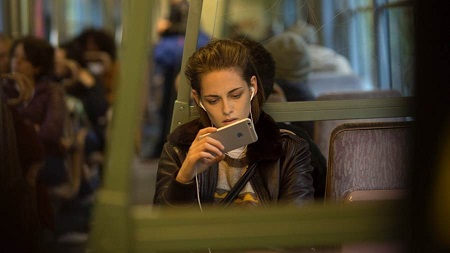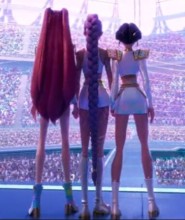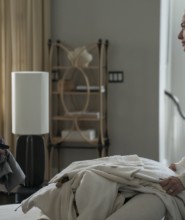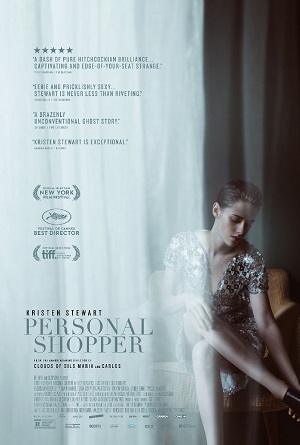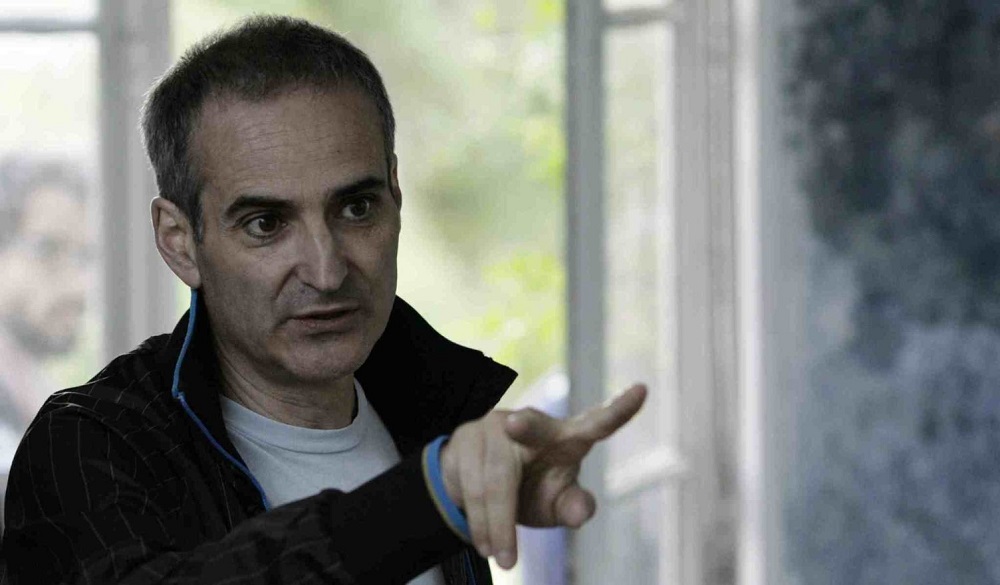
“Personal Shopper” – Interview with Olivier Assayas
by Sara Michelle Fetters - March 22nd, 2017 - Interviews
Connecting the Invisible to the Physical
Olivier Assayas Journeys into the Supernatural with the Haunting Personal Shopper
Olivier Assayas’ Personal Shopper is an unusual ghost story in that it isn’t a tale of horror even if tension and suspense run through the entire picture as if they are the emotional fuel feeding the narrative engine. The story of an American, Maureen (Kristen Stewart), living in Paris working as the personal shopper for a demanding German supermodel, the movie is never exactly what it seems. In this case, the young woman is also a self-described medium who hopes to contact the spirit of her recently deceased twin brother, the sibling promising to proof to his sister the existence of the afterlife if he was to succumb to the rare, not usually fatal heart condition both of them suffer from.
The movie is an existential stunner, anchored by a performance from Stewart that is arguably the best of the actress’ career. Yet, for Assayas, moving into the realm of the supernatural to tell such a human story of loss, grief, longing and hope wasn’t as far afield from any of his previous, more traditionally grounded motion pictures, including such works like Irma Vep, Summer Hours, Carlos and Something in the Air, as some viewers might initially assume.
“I think in some ways all my movies have been ghost stories,” he says wistfully. “All of my movies, they deal with the connection between the invisible and physical, and when I started writing Personal Shopper I really wanted to try and make the specter real, and instead of emphasizing some sort of supernatural being maintain an undercurrent of communication where these things are possible. I wanted to show here that the communication between the invisible and the physical wasn’t just possible but was, if not a given fact, certainly an issue. I knew I was going in the direction where I would have to deal with [this], and I was very excited by that notion.”
With that in mind, and having just worked with Kristen Stewart on his award-winning previous film Clouds of Sils Maria, the director found that he was writing this new script with the actress still at the forefront of his mind. “We have a way of communicating that’s nonverbal,” explains Assayas. “I think we have a lot in common. The same way I love making movies, the way I love that movies capture something about the experience of the world, I think Kristen has a very similar vision. I think she has certain sensitivities that are attuned to the natural, dark magic of filmmaking. She understands it.
“When I started imagining this film and this character, the idea of going into areas that I had not experimented in that much before, I felt I only could do it if I had the right actor. It had to be a partnership. With Kristen, she’s always bringing everything back to reality. She can make anything feel true and believable. It’s an extraordinary talent. I knew that I could venture into weird areas because wherever I would go I could trust that Kristen would bring it back to reality and share that with the audience. She was the medium I needed. Not just the medium she was playing in the movie, but to also be the medium that connects the audience with the story the movie was telling. Kristen could make that happen.”
The crux of the story revolves around Maureen’s relationship with her dearly departed twin brother, an intimate connection between siblings that’s purposefully played as subtly as possible, Assayas only parsing out information as to the closeness of the duo as needed to help propel things forward. “Where I started from was with this lonely character, a stranger in a strange land, and loved the idea of her sharing her emotions with the audience physically,” muses the director. “It wasn’t so much the idea of telling the audience what was going on as it was having them be with [Maureen], to experience whatever it was she was going through.
“Which is also why I needed the genre elements for this film. If I wasn’t going to explain what was going on, I needed to make sure that fear the character was feeling, that sense of mystery, was there for the audience from the start. It really was all about sharing her emotional state, being in that moment with her. That was what I wanted most.”
As part of that, the look of the actual ghost itself was key. How much to show, how concrete and corporeal to make it, those were all questions the filmmaker had to answer, especially considering he was going to reveal early on that this apparition attempting to speak with Maureen was far from being a figment of her imagination. “It took a while to get it right,” admits Assayas. “I went through a lot of iterations [of the ghost] in order to find what I wanted. I had a clear notion of what it was I wanted, my inspiration was the spiritual photography of the late 19th century, and this was a reproduction of the way they would look at the supernatural inside those images. Finding that took some time.
“I also drew on descriptions of séances by mediums from that time period. I collected a lot of descriptions and recounts of what it was they claimed to see. I wanted to try and reproduce that, which was easier said and done. We went through a lot of trouble to find the look.”
On the opposite end of the technological spectrum, another device Assayas uses to generate suspense are a series of mysterious text messages between Maureen and anonymous entity who might be supernatural in origin. “It was a challenge,” laughs the director. “Those text messages, they were both easy and difficult. It was easy in the sense that I don’t think there is any sort of specific tension involved in watching a person type on a phone, so that was relatively easy to film. But, I think, the way to generate tension when filling your scene with a smart phone’s screen is in the waiting for a reply and trying to find the right wording in regards to those respones. I like the normality of it, the way we multitask when we’re typing a message, how mundane that is. Yet there is a mystery in the response. It’s like opening a package. You really do not know what is going to be said.
“It’s not like anything else. It’s not like a phone conversation and it is certainly not like writing a letter. Text messaging, it’s an inherently odd way of communicating. It’s all anticipation. For me, it was trying to stretch that anticipation as far as I could because if that tension could be generated then it would become an important emotional component of the film. So, doing that, it was difficult to find the right rhythms, to find the right methods to make maintaining that tension possible. Every tiny detail affected the whole entire scene.”
“Of course, Kristen’s acting in these scenes was also vitally important,” adds Assayas. “It’s not just someone typing, it’s Kristen as Maureen typing and reacting. It’s the way she expresses emotions that are not always instantly readable, that helps make the tension even more potent. It’s very, very complex, even more complex than I imagined when I wrote the script. Kristen just made it all look so easy, and in reality it was actually quite difficult.”
Which feeds right into the filmmaker’s typical working style. No matter what the film or the genre, Assayas assumes his audience is intelligent, that they can figure out the ins and outs of what is going on without extraneous pieces of exposition. “You get away with doing that if you make movies that aren’t too expensive,” he says with a sly wink. “If you do that with a more expensive film, you can’t get away with it. Here, a movie like Personal Shopper would never get made without someone like Kristen, and I’m very grateful for that. We’re taking risks here, and we’re doing it on a relatively small budget, and she’s taking even more major risks as an actress, and because of all of that we had to manage to make the film on something like a little less than $5-million.
“But a budget like that allows you to embrace those risks and really go for what it is you’re dreaming about achieving. Additionally, I feel very lucky to be working within the framework of the French indie system. In France, we do have support for films like this. There is this notion that movies are art and they should be supported as such. I’m not sure that functions the same way here with the studios much of the time.”
Having worked within the confines of that French system for over three decades to great critical acclaim and general audience adulation, the filmmaker is still surprised by just how passionately his films are embraced and discussed. “I kind of like it,” Assayas laughs. “I find waiting to discover how people are going to react to my movies exciting. It makes all of this hard work worth it.
“I like trying things. I like to take risks. If I ever stopped taking risks I think I’d want to stop making movies. I’d find that boring. I like Ken Loache. He is a great filmmaker. But I could never make the kind of movies he does. I don’t like the idea of making the same type of movie over and over and over again. I need a challenge. I need variety. I like the idea that I am going to have a different dialogue with the audience each time out, and I enjoy seeing how they are going to react. Sometimes the audience sees a certain name on a movie and they know exactly what to expect.
“If I do my job correctly then the audience cannot know what to expect just because they see my name attached to the movie. I want to wake up the audience. I want to catch them off guard. That’s the sort of challenge that continues to excite me.”
– Interview reprinted courtesy of the SGN in Seattle

